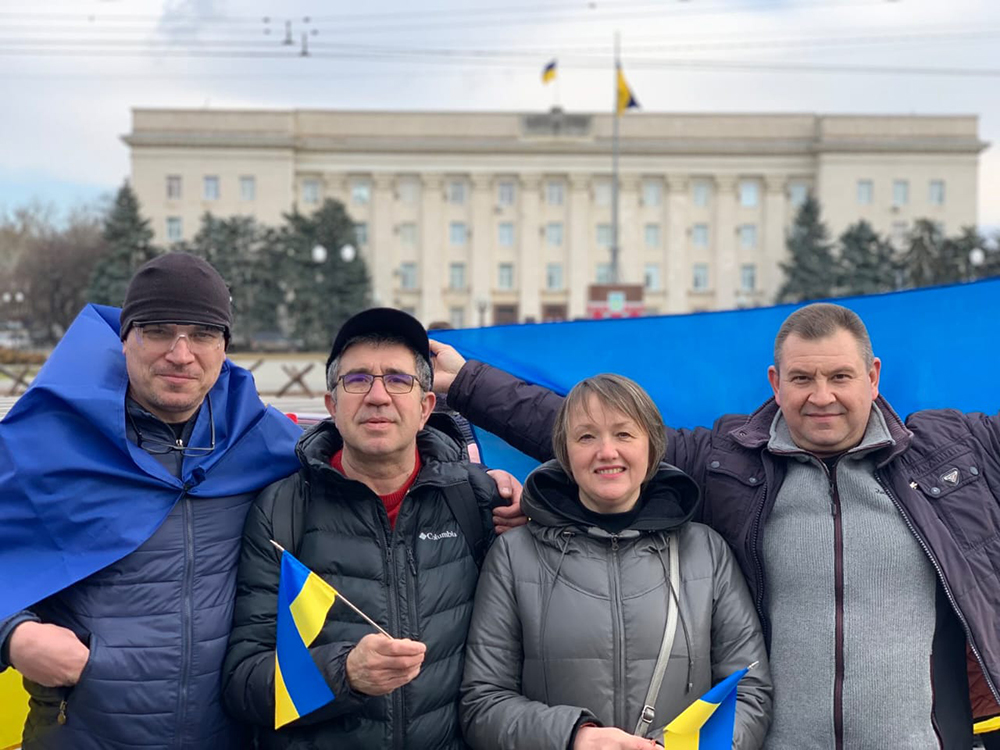
On Aug. 2, around 11 a.m., Angela was at work when her husband of 32 years, Serhiy, drove their car home from the auto repair shop and parked it under a leafy tree to hide it from a drone. Just a week earlier, a Russian drone had damaged the couple’s car for the second time. In spring 2023, the first attack had also injured Serhiy, 54, who, like most Kherson residents, lost his business during the full-scale invasion but maintained his sense of humor and high spirits.
Serhiy walked across the empty yard and stopped in front of the building entrance to chat with a neighbor, an elderly lady on a bench. It was then that they both heard the loud buzzing of an approaching drone. The neighbor rushed inside. Serhiy darted to his car, but the drone dropped a grenade on him. A piece of shrapnel hit him under the left shoulder blade, pierced his heart, and killed him on the spot.
“Serhiy loved life, good food, joy,” said Angela. “We did not move as our parents live in Kherson, and where would we move, without jobs and money? His grenade found him.”
The fatalistic sentiment, “Your shell will find you even in Kyiv,” has become a mantra in Kherson, justifying staying rather than leaving. After the funeral, Angela remained in her now-empty apartment, listening to the killer drones buzzing day and night over the oncology hospital across the street.
Iryna Sokur, the director of the regional Oncological Health Center, keeps a glass cabinet in her office filled with hundreds of shrapnel pieces found on the hospital premises.
“Our center is located on an elevation on the right bank of the Dnipro River, about one kilometer from Russian positions on the left bank, so drones reach us quickly and easily,” Sokur explained.
“Since the liberation, constant artillery shelling in our area has damaged a transformer substation and a sewage pumping station. In the last two weeks, the situation has deteriorated.
“Every day, we suffer up to four skids—drones dropping explosives on the hospital premises, the surrounding area, personnel vehicles and oncology patients. In the last two days, several doctors’ vehicles, ambulances and passenger cars were deliberately attacked. Drones fly low, and the operators can see their targets as they drop explosives.”
Civilians around the hospital are under constant attack. Three weeks ago, a drone descended within five meters of the ground, chasing a security guard. Recently, a young man brought his mother, a cancer patient, into the hospital. As he parked the car, a drone killed him.
“We don’t have any military here; we are civilian doctors who treat cancer patients,” said Sokur.
In the past month, Russian drones have also conducted daily attacks on the diesel generators critical to treatment and diagnostic processes. In Kherson, Russian artillery and MLRS regularly damage the central power supply by striking high-voltage cables or substations, leading to outages. Maintenance teams cannot immediately repair the damage due to the “double hit” tactic—where Russian forces target first responders—resulting in extended periods without electricity.
If the hospital is disconnected from the central power supply and the generator fails, it cannot provide medical care to more than 100 cancer inpatients and numerous outpatients. This includes severely ill patients on round-the-clock chemotherapy, patients on oxygen support, those receiving radiation therapy and those undergoing surgeries. Essential services such as laundry, food preparation, laboratories and sterilization also require electricity.
Russian drone operations have shown increasing innovation, shifting from dropping one grenade to deploying three large grenades or inserting nails into discharges. The nails not only injure people but also scatter across roads, cutting tires and hindering the response of ambulances and medical staff vehicles.

Drones Conduct Remote Mining and Incinerating
Nails and sharp objects embedded in improvised explosive devices are just a small part of the arsenal used to kill and maim. The Russian military employs drones for remote mining operations, recently deploying banned PFM-1 anti-personnel landmines, commonly known as peliustki or lepestki, in the center of Kherson.
Stepping on a lepestok can result in severe injury or limb loss. These mines are particularly insidious due to their small size and ability to blend seamlessly with natural surroundings, such as grass and leaves. Smoking or using an open flame near these mines could trigger a detonation.
Fire has become another widely weaponized tool of the Russian military. Serhiy Ivashchenko, head of the Antonivka district in the Kherson region, explained that drones use a standard multi-step maneuver: first, they destroy diesel generators that pump water from wells, cutting off the neighborhood’s water supply, and then they set houses and dry grass on fire by dropping incendiary mixtures on roofs and lawns.
Firefighters are often unable to respond as Russian drones and artillery employ a “double tap” tactic, targeting them when they arrive. Every day, several houses in Antonivka burn down.
Tetiana and Ilya Shuvalov, a couple in their 30s, had to abandon their house in Antonivka after a third drone attack on their car and home, followed by a massive fire on their street. Along with their rescue pets—two dogs and three cats—they relocated to Kherson, where they now live across the street from another house burned by a Russian drone. “It’s a bit safer here, still,” said Ilya.
“Torching blocks is a systematic approach. We often receive calls to demine two buildings next to each other within two days, both set on fire by drones dropping incendiary mixtures,” said Volodymyr Perepelitsya, head of the explosive services department of the National Police in the Kherson region. “It’s a mass phenomenon.”
Intensifying Russian Drone Assaults Force Evacuations in Kherson
In June and July 2024, the Russian military deployed up to 100 drones per day to kill civilians and burn entire neighborhoods in the Ukrainian-controlled areas of the Kherson region. In July alone, civilian casualties from Russian drone strikes doubled. On Aug. 10, due to the intensifying drone attacks, the Kherson military administration expanded the mandatory evacuation list to include a total of 50 settlements in the de-occupied territory of the Kherson region.
“The frequency of drone attacks has escalated,” said Andriy Kovany, press officer of the Kherson Oblast National Police Headquarters. “Previously, these attacks were more prevalent in settlements along the Dnipro River, but now they are increasingly affecting the city of Kherson. This is a hunt for civilians.”
On Nov. 11, 2022, when the Ukrainian Armed Forces liberated part of the Kherson region on the eastern bank of the Dnipro River, the Russian military retreated to the western bank. From this proximity—sometimes as little as one mile—they have launched relentless attacks on the city of Kherson, its suburbs and surrounding villages.
Initially, these assaults relied on MLRS and artillery, later incorporating Shahid drones and guided aerial bombs (KABs). In May 2023, the Russian military began using small drones, known as First Person View (FPV) or kamikaze drones, to target civilians and infrastructure in the Ukrainian-controlled Kherson region.
According to Kovany, in addition to dropping explosive devices, drones are used for reconnaissance to guide subsequent shelling. Perepelitsya explained that drone attacks could be categorized into two main types: explosive discharges and incendiary discharges. In simpler terms, some drones are designed to kill and injure civilians, while others are used to torch residential areas.
International humanitarian law prohibits attacks intentionally directed against civilians or civilian objects to protect non-combatants during armed conflicts. The deliberate targeting of civilians violates the Geneva Conventions. Additional Protocol I (1977) to the Geneva Conventions explicitly prohibits attacks against civilian populations and civilian objects. These deliberate, escalating assaults constitute clear war crimes and demand immediate international attention.

